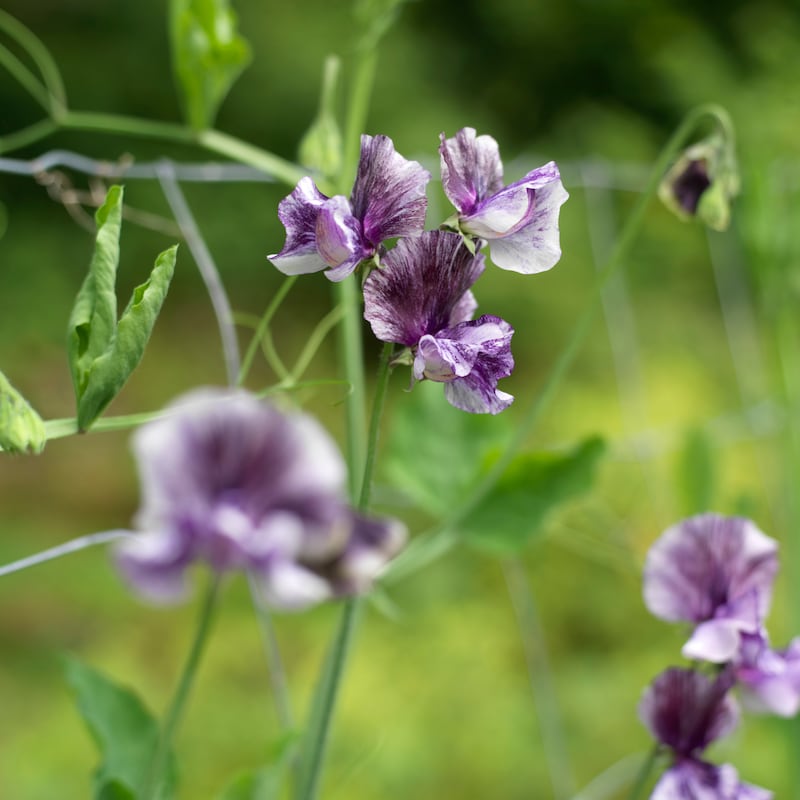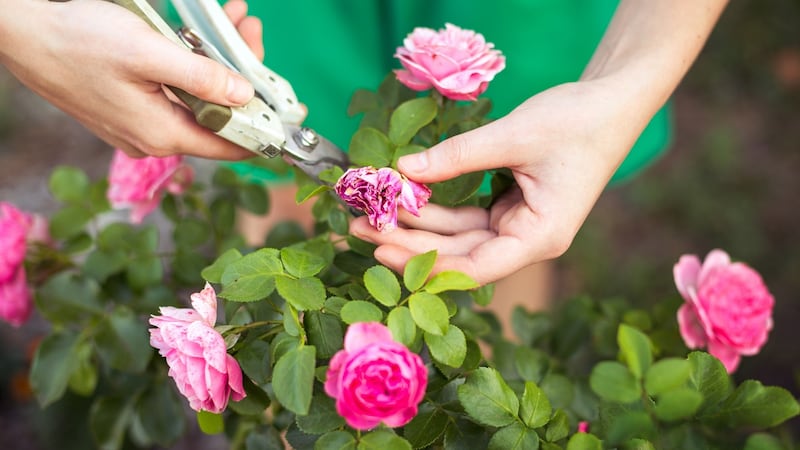I picked a small bunch of sweet pea flowers from the garden today, snipping off their stiff, slim stems with a scissors and shaking the rain from their soft, ruffled petals before bringing them indoors to fill the house with their distinctive scent, a cloud of perfume that never fails to seduce.
Frustratingly, this year’s plants are struggling to perform well. Most of my first batch of autumn-sown seedlings (normally the best way to raise strong, vigorous, early-flowering sweet pea plants), which are hardy to temperatures of about minus-five degrees, were killed by the fierce cold of December, when temperatures dropped into double figures below zero. Accepting my losses, I sowed a second batch in early spring, which was damaged by slugs and snails.
Those that survived were planted out in late April into their final growing positions outdoors. A hungry, thirsty species that needs plenty of time to plunge its young roots deep into cool, rich, moist soil, the baby plants then had to contend with the near-drought conditions caused by this year’s one and only heatwave. Unsurprisingly, they sat and sulked. The endless rain that followed helped a little, but sweet pea plants also need plenty of heat and bright sunlight to thrive, neither of which they have got so far. It’s all a very different story to last year’s long, warm summer when the high old stone wall next to our little farmhouse was covered with a froth of their scented flowers and twining stems by late June.

Despite my struggles, I can’t imagine a summer without this plant (Lathyrus odoratus), whose cultivation can be traced right back to the 17th century when a Sicilian monk by the name of Francesco Cupani wrote of discovering a wild species with dark purple-maroon, deeply perfumed flowers. Exciting the interest of botanists, plant breeders and gardeners around Europe, seed of Cupani’s plants made its way to England, which soon became the spiritual home of this supremely decorative hardy annual.
The first big breakthrough in breeding came with the famous British sweet-pea hybridiser Thomas Eckford – the “father of sweet pea”. He succeeded in producing what became known as the Grandiflora sweet pea, which kept both the graceful nature and intense scent of Cupani’s plants but produced larger flower spikes in a much wider range of colours. Examples of his ground-breaking work include the violet-blue “Lord Nelson” and dark-pink “Black Knight”.
Then, in 1901, came the frilly petalled, bright-pink “Countess of Spencer”. This famous variety, named by Silas Pole, the head gardener of the Earl of Spencer at Althorp, but probably the result of seed produced by Eckford, was the very first of what are now known as Spencer sweet peas. Some gardeners remain steadfastly sniffy about their flamboyantly beautiful flowers and weaker scent – there are mutterings of “vulgarity” – but this much-loved strain is still prized by many gardeners and flower arrangers for its long stems and very large, colourful, gently frilled flowers.
The supply of high-quality, hand-harvested sweet pea seed is under threat globally as a result of climate change
Over the years, plant breeders around the world including in Ireland as well as in New Zealand, Australia and the United States, have subsequently introduced countless garden-worthy varieties of sweet pea into cultivation. Some stand out for their intense perfume (for example, the white and violet variety “High Scent” bred by the renowned New Zealand breeder Dr Keith Hammett) or for the number of flowers per stem (“Big Blue”). Others are prized for their early-flowering growth habit (“Winter Sunshine” and “Solstice” series, both suited to growing under glass/in a polytunnel), for their compact growth habit (for example, the Cupid series, bred by the famous American seedsman Washington Atlee Burpee), for the unusual colour combinations of their flowers (for example the bicoloured “Turquoise Lagoon”), or the fact they change colour as they age (“Blue Shift”).
The result is a wealth of choice than can often feel overwhelming. Over the years I’ve grown more than a hundred different varieties, from the oh-so-fashionable flaked purple “Earl Grey” and the classic “Anniversary” (pale pink) to the charming pale-blue “Bristol”; the bicoloured lavender-and-pink “Erewhon” (I feel like the only gardener on the planet who didn’t fall in love with this famous variety); the enduringly lovely “Piggy Sue” (pale apricot-pink) and “April in Paris” (another delicately coloured, picotee variety. Many of the best belong to the group known as modern grandifloras, which succeed in combining most of this exquisite climber’s very best traits in terms of scent, vigour, length of stem and variety of colour.
I say a “wealth of choice”, but this is unlikely to be the case for very much longer. The supply of high-quality, hand-harvested sweet pea seed is under threat globally as a result of climate change, skilled labour shortages and the dwindling number of seed producers and breeders with sufficient horticultural knowledge to maintain existing varieties in cultivation as well as to produce new ones, a sad metaphor for the strange new world we live in.
[ Frilly but not fragile: how to grow a hardy sweet peaOpens in new window ]
Recent photographs from Dr Hammett’s fascinating Instagram feed @drkeithhammett show some New Zealand growers’ sweet pea plants sitting in flooded fields, a result of extreme weather conditions. In other posts he has appealed for a new generation of breeders to come forward to take on the legacy of previous generations’ skilled work before it’s lost. The Washington state-based plant breeder, author and flower-farmer-florist Erin Benzakein, aka Floret, is also sounding the alarm about the very real risk of much-loved varieties eventually being lost to cultivation, or becoming far more difficult to source as quality seed in the near future.
The good news is that one of the simplest and most rewarding ways to secure supply of a favourite variety is by allowing a few plants to set seed and then home-saving it. Sweet pea is what’s known as self-pollinating, with its flowers being pollinated by the plant before they open to visiting insects, the same reason why they are relatively easy to hybridise. The result is that it’s quite easy to save seed that will be true to the parent plant just so long as you make sure to remove any “rogue” varieties that might appear over time. If you have space to isolate individual varieties in the garden or allotment by growing them 1.5m away from each other, all the better.
In a normal year, ripe seed will become ready to harvest from the end of July and is easily identified by the fact that the pods become dry, hard and stiff and change in colour from pale green to beige-dark brown, as do the seeds themselves.
As is always the case when home-saving seed, choose a warm, dry day to harvest these, before placing them in a paper bag and putting them somewhere dry and out of direct sunshine to dry for a few weeks. Sweet pea seed is poisonous, so make sure to keep out of reach of young children. Once you’re sure that they’re properly dry, the seed pods can be stored in a paper envelope or in a fridge (the latter method means that they’ll remain fresh and viable for several years) until needed, at which point simply open the pods to release the individual seeds. But just don’t forget to label them. After all, you don’t want any of those much-maligned Spencer varieties ending up in the wrong hands.
This week in the garden

Deadhead, deadhead, deadhead – yes, it’s boring and time-consuming but regular deadheading is crucial at this time of year in order to maintain a great show of flowers over the coming months. Without it, many plants, including sweet pea, will stop flowering as they turn their energies to seed production. Deadheading is also a good way of preventing some very vigorous species from self-seeding too abundantly in the garden. On the other hand, don’t deadhead plants if you want to save seed or if they’re species that are valuable for their ornamental/bird-friendly displays of seed heads, hips or berries. See rhs.org.uk for further advice.
This summer’s prolonged cool, wet growing conditions mean that it’s more important than ever to keep glasshouses and polytunnels very well ventilated and to keep a beady eye out for plant diseases before they spread. Good garden hygiene is also imperative in terms of regularly removing any dead, damaged or diseased plant material (bag the latter and remove it off site).
Dates for your diary
July 29th-August 5th: Carlow Garden Festival 2023, with an outstanding line-up of expert and inspiring speakers, including Adam Frost and James Alexander Sinclair at Leighlinbridge Garden Centre (July 29th), Robin Lane Fox at Borris House (August 3rd), Seamus O’Brien at Hardymount Gardens (August 1st), Matthew Wilson and Alys Fowler at Altamont (August 4th), Kitty Scully at Shankill Castle (August 2nd), Nick Bailey at Duckett’s Grove (July 30th), Colm O’Driscoll at Burtown (August 2nd) and Fergus Garrett at Huntington (August 5th). carlowgardentrail.com. Booking is essential.












